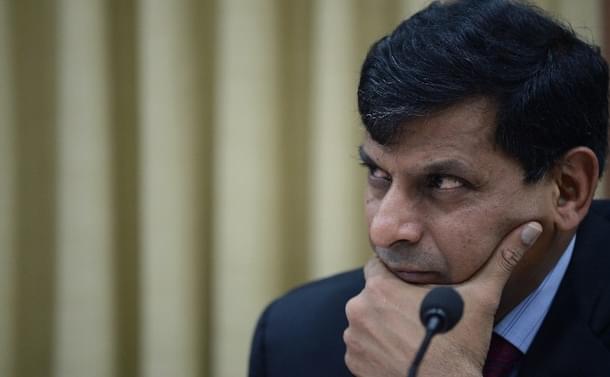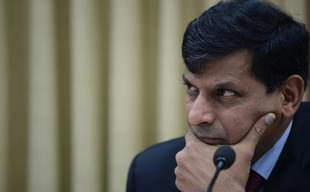Economy
An Early Diwali
Gautam Mukherjee
Sep 30, 2015, 11:38 AM | Updated Feb 24, 2016, 04:28 PM IST
Save & read from anywhere!
Bookmark stories for easy access on any device or the Swarajya app.


How Raghuram Rajan has been trying to modernise the RBI, PSU and other private high street banks.
RBI Governor Raghuram Rajan said his surprise 50 bps repo rate cut effective September 29th was made possible, because of improvements on the ground, consistently lower commodity prices, and an inflation rate target of 6% for this fiscal, more or less met.
He protested, amid dimpled smiles, that he wasn’t playing Father Christmas or announcing a Diwali bonus. And yet, as the retail bank honchos announced that they too will shortly lower their lending and home loan rates amongst a clamour for ‘transmission’ of the easier money policies, it certainly feels like it. State Bank of India got off the ground first and has already cut its lending rate by 40bps to 9.3%.
This will also have happy consequences on the high home loan scenario and may go some way to revive the stagnant residential housing market. The bourses, started the day on the 29th pessimistic, with cues from the SGX Nifty indicating an over 100 point cut, but this changed quite dramatically sometime after 11.00 am IST, once Rajan made his unexpected announcement. It wasn’t unexpected because it wasn’t warranted and even overdue, but the RBI governor rarely saw it the same way as the street in the past.
And yet, the RBI has cumulatively lowered the repo rates from 8% to 6.75% in this year alone, and there will be another late year review yet. Some commentators are suggesting the front-loading of optimistic monetary policy has, in fact, just begun. From the sounds of it, the lower interest regime will almost certainly continue through 2016 and onwards, ushering in robust growth prospects. There may be a lag as industrialists gather their confidence, but business and industry should, in all probability, make bold to expand on the back of this supportive policy direction, that is no longer hawkish about the future.
It is a curious coincidence that America will probably start raising rates in 0.25% increments, sometime soon, perhaps once in six months, while we lower them likewise but more likely once in three. But the US is hoping to stimulate a modicum of inflation from their near zero situation.
And while it will be quite some time before the US interest rates are at, say, 4%, we may be there in just over two years from now if we proceed at the current pace. We are of course, hoping that our inflation will keep dropping to perhaps 3% in order to make the low interest regime sustainable for the decades of growth we need to turn this country into a developed one.
But for now it is a relief to see that at last, the RBI is sounding optimistic about the future, projecting a 5.5% inflation rate for 2016-17, and a simultaneous growth rate of 8% for the last quarter of this fiscal itself. Rajan, whose three-year term comes to an end in 2016, is now largely on the same page as the government that has been exhorting him and his autonomous central bank to lower rates for quite some time.
Since the governor enjoys considerable international credibility, recognition, and prestige, it might be a good idea, in the changed scenario, to let him stay on, and give him a second term at the RBI.
To be fair, Raghuram Rajan has been making a number of efforts to modernise and improve the functioning of not only the RBI, but the various PSU and other private high street banks, and more time at his disposal will make the task easier. He was instrumental in pushing through the implementation of the launching of a number of small banks and payment banks recently. Rajan has also been critical of the manner in which humungous corporate NPAs fall on the necks of the tax payer at present. This, even as the promoters of various defaulting companies go scot free.
Raghuram Rajan can certainly help Modi’s government and its ministry of finance/commerce/company affairs, find ways and means to make such defaulters more accountable. More so now that he has stopped raining on its parade with his economically morose outlook and ever-tight monetary policy.
Of course, it was only a couple of days ago, as the will-he-won’t-he debate raged, that the irrepressible senior sharpshooter of the BJP Subramanian Swamy, suggested that Rajan should be sacked if he didn’t cut this time too. But now, all is certainly forgiven, particularly amongst the pile of optimistic comments made by the governor in context.
Politically too, this government may be setting the stage to wrest another term in power come 2019. This will look increasingly probable if the NDA wins outright, nearly wins, and/or forms the next state government in Bihar, post the assembly elections in October/November.
The international community interested in investing in India too is bound to be pleased about the RBI’s signal that the economy has righted itself, and is on the path to sustainable growth.
This will be reflected in the form of renewed stock market investment into India with higher weightages, despite the threats posed by the economic decline of China and the possibility of capital flight when America reverses its interest rate policy. This more so in the context of Narendra Modi’s strenuous efforts to get his ‘Make in India’ and ‘Digital India’ initiatives going with the help of massive FDI. The blood moon and lunar eclipse seem to have done well for India, and by 2033, when the phenomenon occurs again, this should be a very different kind of place.
Gautam Mukherjee is a political commentator whose columns figure regularly in different right-of-centre media outlets





